
Rving from 1951 to 1960
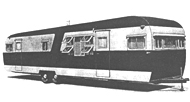
1951, Landola tandem travel trailer
Source: Atlas Mobile Home Directory
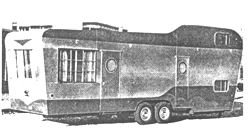
1952, Highlander Boyer
Source: Atlas Mobile Home Directory
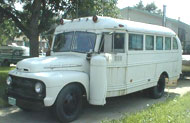
1952, Ford Bus
Source: www.rvs-r-us.com
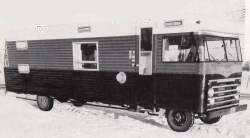
1953, Frank Motor Home
Source: www.rvs-r-us.com
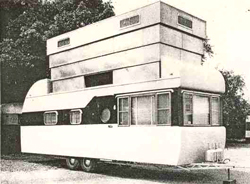
1952, Space Queen
Source: Atlas Mobile Home Directory
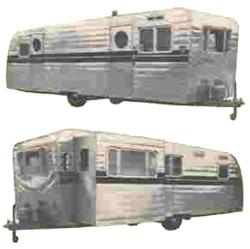
1952, Rollohome
Source: Atlas Mobile Home Directory
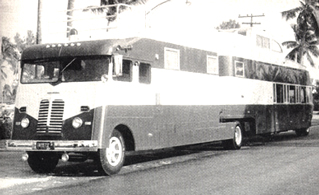
1952, Executive Flagship
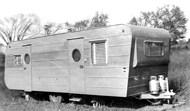
1953, Schult 8x27
Source: Atlas Mobile Home Directory
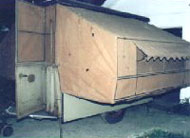
1953, Gilkie Deluxe
Source: nccamper.tripod.com
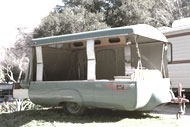
1954, Ranger Pop-Up Trailer
Source: www.funkyjunkfarms.com
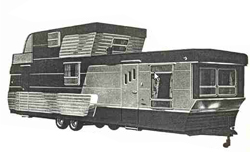
1955, Richardson Regent Bi-Level
Source: Atlas Mobile Home Directory
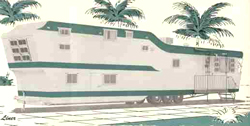
1955, Smoker Vista Liner
Source: Atlas Mobile Home Directory
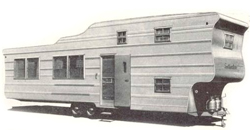
1955, Southwestern
Source: Atlas Mobile Home Directory

1956, Spencer Teardrop
Source: www.lnqs.com
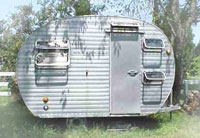
1954, Lil Abe
Source: Atlas Mobile Home Directory
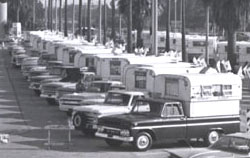
1958, Alaskan Campers
Source: alaskancamper.com
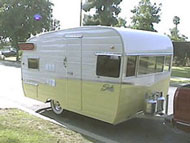
1959, Shasta Airflyte
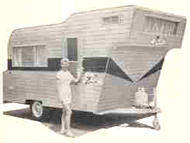
1960, Boles-Aero Zenith
Source: Atlas Mobile Home Directory
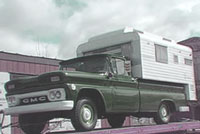
1960, Rocinante
Source: National Steinbeck Center
During the 1950s mobile homes and travel trailers appeared on the RV scene in a more interesting way than ever. RV designs expanded in size and length. Increased living spaces, luxury interior decor, modern conveniences such as generators, refrigerators, real plumbing systems, complete kitchens and bathrooms transformed and accelerated the RV industry. The 1950s were the decade of full bloom for the large trailers and motor coaches. First motor coaches with a body and interior built on a factory chassis and on a rear engine pusher chasis were built. By the end of the decade, the market clearly distinguished between mobile homes or travel trailers for full time living and travel trailers used for vacation.
In 1951, Landola trailers were available in two models, 32 and 37 feet long. Both models feature ventilating type picture windows and aluminium exterior. The 37 foot Model 800 contains a triple-fold door that enclosed the bolster bed to provide a private bedroom at the front of the trailer. A handy adjacent washroom was also provided. This model is furnished with a shower, toilet, large bedroom, deluxe kitchen with snack bar and an 8 cu. ft. electric refrigerator.
Upstairs, downstairs, terraced... These are features of the 1952 Highlander model. The coach is claimed to have, in the 30 foot model, an interior floor space equal to that of single level trailers up to 37' 6" in length. The interior features a 3-level terraced construction plus an "inverted" arrangement. Two-thirds of the interior is said to have a 7' 5" ceiling height. A complete bathroom and two private bedrooms are standard.
School buses were also a popular base for building custom motor homes like the 1952 Ford school bus seen here.
Then in 1953, Ray Frank started a new industry when he built an all-weather travel vehicle for his family and he called it a "motor home". His motor home sat on a Dodge truck chassis. Responding to the great interest created by his first vehicle, Frank Ray began manufacturing motor homes.
This amazing two-story Space Queen trailer from 1952 was built for only one year. The manufacturer, Gemco Engineering & Mfg. Co. from Cincinnati, Ohio did not stay in business long. The trailer was 26 feet long and 8 feet wide. The center bedroom compartment raised to the height of 19 feet. It had a fully equipped kitchen, living room and bathroom on the first floor and two bedrooms with double beds on the second.
Rollohome Trailer Coach, located in Marshfield, Wisconsin, built the Rollohomes into the 1950s. The 1952 model offered the very first so-called "pull-out rooms" which were pulled out manually from the outside of the trailer. The trailers were 8 feet wide and 26 feet long and came with or without the pull-out room. Today's slide-out became widely available in the 1990s.
Built by Mid-States Corp., Los Angeles, in 1952, the Executive Flagship was the biggest house trailer ever to hit the road. It was 65 feet long, 16 feet wide and 13 1/2 feet high. It weighed 18 tons and rolled on 10 wheels. This huge rust-and-ivory land yacht was luxuriously equipped with kitchen, two bathrooms, seven-foot bird's eye maple bar, two refrigerators, wall-to-wall carpeting, radiophonograph, 21-inch TV, movie screen, indirect lighting, wine cellar, air conditioning, intercom, radiotelephone, and "pooch porch" for the dog. It had portable swimming pool, 23 feet accross, with diving board. The upper sun deck could be used to board a helicopter. Six people could sleep. It was so big that it required a special permit to cruise on the road. The price for this house trailer was $75,000.
In 1934 Walter O. Wells and Wilbur Schult opened a shop in Ekhart with 20 carpenters and produced their first Schult trailer. Wilbur Schult was credited as the first man to begin RV manufacturing.
By April of 1937, Schult had 2 plants in Elkhart with over 250,000 combined square feet of manufacturing space and had created a division in Ottawa, Ontario, Canada. He produced over 1500 trailers in 1937. He continued his dramatic growth and opened a division in Christchurch, New Zealand making him perhaps the first manufacturer producing units in three countries and on two continents.
Schult Trailers produced many industry innovations. They were the first manufacturer to extend their units standard width from 7 1/2 to a full 8 feet and the first to offer 7’ foot ceilings. They were the first manufacturer to build a full steel frame under their entry level products. Schult Trailers designed and installed an optional full trailer "air conditioning system" which circulated air over a vault of ice to cool the trailer.
Schult also built the trailers for the famed 1947 Gatti-Hallicrafters African Expedition.
In 1957, the Schult Trailer Company evolved into the Schult Mobile Home Company and turned its attention completely to the manufactured housing industry. This company continues today as Schult Homes.
In the sidebar you can see a Gilkie tent trailer from 1953 in its unfolded position. Gilkie trailers had been introduced in the 1920s, and were built in Terre Haute, Indiana, by E.P. Gilkison & Sons. Inside these remarkable little trailers included a wash basin, ice box, two beds/foldable couches, electric light hook-up, storage box, under bed storage, linoleum floor and fold out cooking tables. Features included rear and side window awnings, copper mesh screens, spoke wheels and a two-piece door.
The Ranger pop-up tent trailer was made with a fiberglass body. The manufacturer was Hille Engineering Corporation, Anaheim, California.
To keep up with the competition, Richardson Homes Corp. from Elkhart, Indiana, came up with an ingenius 2-story design in 1955. The trailer had two upstairs bedrooms with a rear exterior balcony. Downstairs boasted a large rear master bedroom, center bathroom, center kitchen and front living room. The mobile home was designed to be pulled without needing an over-sized permit and was capable of sleeping up to eight people.
Smoker Lumber Company fron New Paris, Indiana, primarily built custom homes in the upper price range. Their homes were extremely well-built and high quality. In 1955, they were not only producing the longest trailers (55 ft.), but came out with a unique two-story type mobile home called 'Vista-Liner'. The two-story part was on the front, or hitch end of the unit. It boasted four bedrooms and two baths. The downstairs had a short little escape door out of one of the the kid's bedrooms. The kitchen was in the center with the living room at the rear.
In mid 1955 Southwestern came out with a two-story trailer in a 35' length. Later they manufactured much larger 2-story homes in both 8 and 10 foot wides. The coach features three bedrooms, all privately accessible to the bathroom. It slept up to eight comfortably.
Teardrop trailers made their appearance around the 1930's, and flourished through the 1940's, and 1950's. Many of the teardrops were built by individuals who followed plans that appeared in Popular Mechanics.
In the 1950s Lincoln Mobile Homes offered tiny egg-shaped campers called "Abe's Campers" that could sleep three or four persons. All models had stove, sink, refrigerator, bed and dinette which easily converted to a bed.
In 1953, Don Hall designed a popup truck camper for a three-month trip to Alaska. But the demand for this camper was so great, he started building them for the public in 1958. In five years, five factories were building Alaskan Campers. In another two years, two more factories were built in Canada and two factory outlets opened. The first unit was constructed so that the top, by an hydraulic system, could be raised and lowered. This allowed for full standing room in the interior when in camp, but when on the road, the unit was snugged down with only a few inches of camper roof extending above the truck cab. The result was reduced wind resistance and increased gas mileage.
The 1959 Shasta Airflyte travel trailer had two little wings on the back, a Shasta trademark of the era. Shasta Industries, founded in 1941, is the oldest continuous manufacturer of recreational vehicle in USA. A producer of class C motorhomes, fifth wheels and travel trailers, Shasta is a division of Elkhart-based Coachmen Industries, now owned by Forest River Inc. This small "building on wheels" was one of the most popular travel trailers back in the 1940s and 1950s.
In 1960, Boles-Aero introduced a small, medium priced, 15 foot Zenith model with a very agressive front end design. This is the first model ever to feature the cab-over bed.
In 1960 the writer, John Steinbeck, set out on a cross country trip in a new GMC pick-up truck, with a camper unit attached to the truck bed. The camper had double bed, four-burner stove, heater, refrigerator and lights operating on butane, chemical toilet, closet space, storage space, and windows screened against insects. He named his camper Rocinante.
H.B. McGinness Trailers
WE NEED ANY INFORMATION YOU MAY HAVE ABOUT H.B. MCGUINESS TRAILERS AND THEIR PRODUCTS. PLEASE EMAIL US AT INFO@RVHOTLINECANADA.COM.
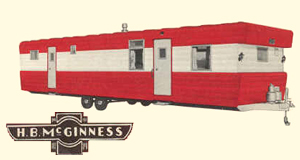
1958, H.B. McGinness Trailer
Source:Atlas Mobile Home Directory
In the 1958, Canadian company, H.B. McGinness Inc., marketed this 10 feet wide model.
RV History 
Did You Know 
The first full-scale automobile was the first of two military steam tractors, completed at the Paris Arsenal in October, 1769, by Nicolas-Joseph Cugnot (1725-1804). It reached a maximum speed of 4 km/h (2.5 mph).



